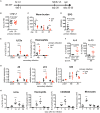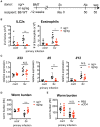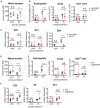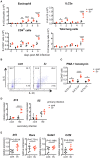Nematode-Infected Mice Acquire Resistance to Subsequent Infection With Unrelated Nematode by Inducing Highly Responsive Group 2 Innate Lymphoid Cells in the Lung
- PMID: 30283458
- PMCID: PMC6157322
- DOI: 10.3389/fimmu.2018.02132
Nematode-Infected Mice Acquire Resistance to Subsequent Infection With Unrelated Nematode by Inducing Highly Responsive Group 2 Innate Lymphoid Cells in the Lung
Abstract
The immune responses against helminths have been investigated individually, and it is well-established that infected hosts develop an immunological memory to resist reinfection by the same pathogen. In contrast, it is poorly understood how the host immune system responds to subsequent infection by unrelated parasites after elimination of the first infection. We previously reported that infection of mice with Strongyloides venezuelensis induces the accumulation of group 2 innate lymphoid cells (ILC2s) in the lung. Here, we demonstrated that S. venezuelensis-experienced (Sv-exp) mice became significantly resistant against infection by Nippostrongylus brasiliensis. N. brasiliensis infection induced enhanced accumulation of ILC2s and eosinophils with increased expressions of mRNA for Th2 cytokines in the lungs of Sv-exp mice. The resistance was dependent on ILC2s, and eosinophils but not on CD4+ T cells. Furthermore, pulmonary ILC2s in Sv-exp mice acquired a highly responsive "trained" phenotype; in response to N. brasiliensis infection, they rapidly increased and produced IL-5 and IL-13, which in turn induced the early accumulation of eosinophils in the lungs. IL-33 was required for the accumulation of ILC2s and the resistance of mice against N. brasiliensis infection but insufficient for the induction of trained ILC2s. In conclusion, animals infected with one type of lung-migratory nematodes acquire a specific-antigen-independent resistance to another type of lung-migrating nematodes, providing animals with the capacity to protect against sequential infections with various lung-migratory nematodes.
Keywords: IL-33; eosinophils; innate immune memory; intestinal nematode; trained immunity.
Figures






Similar articles
-
Intestinal helminth infection promotes IL-5- and CD4+ T cell-dependent immunity in the lung against migrating parasites.Mucosal Immunol. 2019 Mar;12(2):352-362. doi: 10.1038/s41385-018-0102-8. Epub 2018 Nov 6. Mucosal Immunol. 2019. PMID: 30401814
-
Group 2 innate lymphoid cells utilize the IRF4-IL-9 module to coordinate epithelial cell maintenance of lung homeostasis.Mucosal Immunol. 2016 Jan;9(1):275-86. doi: 10.1038/mi.2015.59. Epub 2015 Jul 1. Mucosal Immunol. 2016. PMID: 26129648 Free PMC article.
-
Contribution of IL-33-activated type II innate lymphoid cells to pulmonary eosinophilia in intestinal nematode-infected mice.Proc Natl Acad Sci U S A. 2012 Feb 28;109(9):3451-6. doi: 10.1073/pnas.1201042109. Epub 2012 Feb 13. Proc Natl Acad Sci U S A. 2012. PMID: 22331917 Free PMC article.
-
Role of eosinophils in protective immunity against secondary nematode infections.Immunol Med. 2019 Dec;42(4):148-155. doi: 10.1080/25785826.2019.1697135. Epub 2019 Dec 3. Immunol Med. 2019. PMID: 31794348 Review.
-
Trained innate lymphoid cells in allergic diseases.Allergol Int. 2021 Apr;70(2):174-180. doi: 10.1016/j.alit.2020.11.007. Epub 2020 Dec 13. Allergol Int. 2021. PMID: 33328130 Review.
Cited by
-
The Role of Innate Lymphoid Cells in the Regulation of Immune Homeostasis in Sepsis-Mediated Lung Inflammation.Diagnostics (Basel). 2020 Oct 12;10(10):808. doi: 10.3390/diagnostics10100808. Diagnostics (Basel). 2020. PMID: 33053762 Free PMC article. Review.
-
Impact of Helminth Infections on Female Reproductive Health and Associated Diseases.Front Immunol. 2020 Nov 23;11:577516. doi: 10.3389/fimmu.2020.577516. eCollection 2020. Front Immunol. 2020. PMID: 33329545 Free PMC article. Review.
-
Basophils and Eosinophils in Nematode Infections.Front Immunol. 2020 Nov 27;11:583824. doi: 10.3389/fimmu.2020.583824. eCollection 2020. Front Immunol. 2020. PMID: 33335529 Free PMC article. Review.
-
A Gata3 enhancer necessary for ILC2 development and function.Proc Natl Acad Sci U S A. 2021 Aug 10;118(32):e2106311118. doi: 10.1073/pnas.2106311118. Proc Natl Acad Sci U S A. 2021. PMID: 34353913 Free PMC article.
-
ILC2 Diversity, Location, and Function in Pulmonary Disease.Immunol Rev. 2025 Jul;332(1):e70036. doi: 10.1111/imr.70036. Immunol Rev. 2025. PMID: 40454563 Free PMC article. Review.
References
-
- WHO Guidelines Approved by the Guidelines Review Committee (2017). Guideline: Preventive Chemotherapy to Control Soil-Transmitted Helminth Infections in At-Risk Population Groups. Geneva: WHO Guidelines Approved by the Guidelines Review Committee; (2017).
Publication types
MeSH terms
Substances
LinkOut - more resources
Full Text Sources
Research Materials

